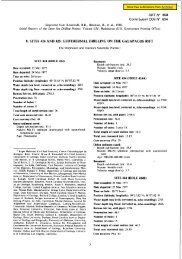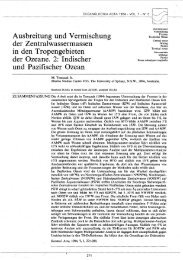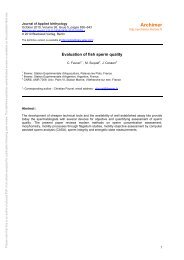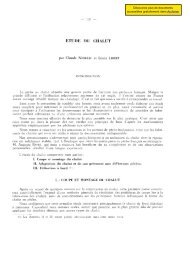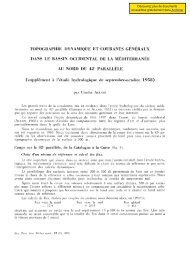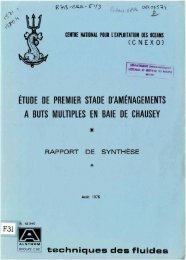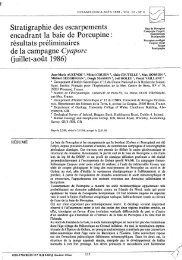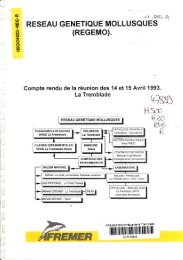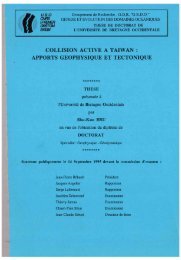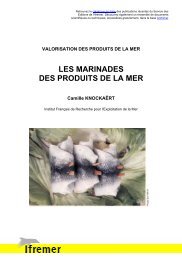Approche quantitative de la fonction de nourricerie jouée par les ...
Approche quantitative de la fonction de nourricerie jouée par les ...
Approche quantitative de la fonction de nourricerie jouée par les ...
Create successful ePaper yourself
Turn your PDF publications into a flip-book with our unique Google optimized e-Paper software.
Chapitre 4 : Impact of vegetation structure dynamics and usage on the nursery function<br />
of West European tidal salt-marshes.<br />
marsh colonisation is observed, especially in the Silversi<strong>de</strong> and Thinlip mullet, since juvenile<br />
and old fish are present at the same time in the marsh, but intermediate age c<strong>la</strong>sses are<br />
absent. The high biomasses of the <strong>la</strong>tter species can also be exp<strong>la</strong>ined by the presence of very<br />
<strong>la</strong>rge individuals weighing over a kilogram.<br />
Tableau 25 : Percentage of each maturity c<strong>la</strong>ss (young-of-the-year, juvenile, adult) of fish species caught<br />
in Aiguillon bay between April 2003 and April 2004.<br />
Tableau 25 : Pourcentage <strong>de</strong> chaque c<strong>la</strong>sse <strong>de</strong> maturité (jeune <strong>de</strong> l’année, juvéni<strong>les</strong> et adulte) <strong>de</strong>s espèces<br />
<strong>de</strong> poissons capturées en baie <strong>de</strong> l’Aiguillon entre avril 2003 et avril 2004.<br />
Aiguillon bay<br />
Species Common name %G0 %G1 %G2et+ N<br />
Parlier et al.<br />
(this study) Elie et al. 1990<br />
Atherina presbyter Silversi<strong>de</strong> 100 - - 34 YoY Settler Euryhaline marine<br />
Dicentrarchus <strong>la</strong>brax Seabass 98,6 0,8 0,6 5 464 YoY Settler Euryhaline marine<br />
Engraulis encrasicolus Anchovy 100 - - 1 063 YoY Settler Euryhaline marine<br />
Liza aurata Gol<strong>de</strong>n grey mullet 95,6 3,8 0,6 2 853 YoY Settler Euryhaline marine<br />
Liza ramada thinlip mullet 66,3 11,5 22,2 2 572 Juvenile Settler Diadromous<br />
P<strong>la</strong>tichthys f<strong>les</strong>us Floun<strong>de</strong>r 100 - - 52 YoY Settler Diadromous<br />
Pomatoschistus microps Common goby 29,37 70,63 - 1 495 Resi<strong>de</strong>nt Estuarine<br />
Pomatoschistus minutus Sand goby - 100 - 1 007 Resi<strong>de</strong>nt Estuarine<br />
Sardina pilchardus Pilchard 100 - - 4 YoY Settler Euryhaline marine<br />
Solea solea Common sole 100 - - 25 YoY Settler Euryhaline marine<br />
Sprattus sprattus European sprat 100 - - 515 YoY Settler Euryhaline marine<br />
A cluster analysis was conducted on the three previously <strong>de</strong>fined size c<strong>la</strong>sses: young-<br />
of-the-year, juveni<strong>les</strong> and adults. Figure 24 shows an organisation into four groups. An O<br />
group (Opportunistic salt marsh settlers) for which the species are present during most<br />
stages, but which are not resi<strong>de</strong>nt species (Silversi<strong>de</strong> and Thinlip mullet). A Y group (Young-<br />
of-the-year salt marsh settlers) including the European anchovy, Pilchard, Common sole,<br />
Floun<strong>de</strong>r and Seabass. These are species for which only the young-of the-year are present in<br />
the salt marshes. Other cohorts can be encountered but much <strong>les</strong>s frequently. The Gol<strong>de</strong>n<br />
grey mullet and European sprat constitute the third J group (Juvenile salt marsh settlers).<br />
These two species are frequent for more than one year in the salt marshes, but the ol<strong>de</strong>r<br />
stages are not encountered. The two species of gobies constitute the <strong>la</strong>st R group (Resi<strong>de</strong>nt<br />
salt marsh settlers). All stages of these species occur because they are resi<strong>de</strong>nt.<br />
127



